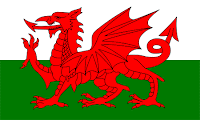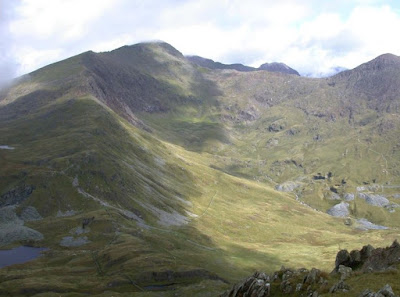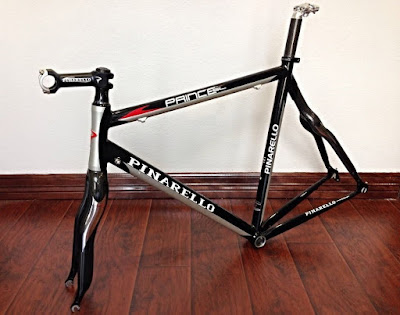 I took a long ride
into Philadelphia on Monday in order to check out the newly-opened connection
across the spectacular Pennsylvania Railroad Bridge near Manayunk, over to the
Cynwyd (pronounced KIN-wood) Heritage
Trail. The bridge is a wonderful addition to the area network of trails, and
provides wonderful views of the surrounding river valley.
I took a long ride
into Philadelphia on Monday in order to check out the newly-opened connection
across the spectacular Pennsylvania Railroad Bridge near Manayunk, over to the
Cynwyd (pronounced KIN-wood) Heritage
Trail. The bridge is a wonderful addition to the area network of trails, and
provides wonderful views of the surrounding river valley.
This connection has been a longtime work in progress and will be a great draw to a section of the city that is already an attraction because of its restaurants, bars/clubs and shops. Unfortunately the approach to the Cynwyd Trail is awkward, as developers failed to re-acquire the right-of-way that would have provided smooth access to the ramp up to the Manayunk Bridge.
 |
| The Manayunk Bridge when it still had rail traffic |
When the route was being planned, I suspect there were objections by property owners in the neighborhood, as it seems the on-road section of the trail could simply have been diverted from Umbria Street to Wright and Canton Streets to reach the ramp. As it stands, cyclists heading towards Manayunk from Umbria Street need to zigzag to the right at a busy intersection with Levering Street and ride up High Street to hit the Cynwyd Trail-head. Those wishing to reach the trail from the canal towpath or from Main Street in Manayunk will face a short, steep climb to the right up Levering Street to reach High Street.
Although Manayunk's bustling Main Street is marked with "sharrows" to allow cyclists to ride in the center of the lane along with motorized vehicles, there is a constant threat of being "doored" or cut-off by customers pulling in and out of parking spaces. The canal towpath is an alternative, but its cinder surface is discouraging to those of us with road bikes. Paving that route would be a great alternative, and again, some access points need to be improved for that option as well.
 |
| Approaching the Manayunk Bridge from the south |
 |
| View of the Green Lane Bridge from atop the Manayunk Bridge |
Certainly the big highlight of the Cynwyd Heritage Trail is the railroad bridge over the Schuylkill, but the rest of the trail forms a two-mile linear park up to the Cynwyd train station, used by SEPTA. Along the way you will encounter interpretive signs about the area's industrial heritage, as well as railroad remnants, like the overhead towers that once carried the catenary (electrified cables) that powered the trains across this line. You might even spot the ruins of Barmouth Station, which until 1986 served passengers on the SEPTA Ivy Ridge Line.
 |
| Cynwd Station, built in 1890, sits at the southern end of the trail and still serves SEPTA passengers. |
If you are like me and aren't intimidated by city traffic, you might even attempt to make a loop from Manayunk, up the Cynwyd Trail then out Conshohocken State Road to Belmont Avenue. There are some sections marked with bike lanes, and once in Fairmount Park, there is a path separated from the street, but I'll warn you that it will be rough on a road bike!
From there I head east on Parkside Avenue, meet up with Girard Avenue and cross the bridge back over the Schuylkill River. A right-hand turn on Sedgley Drive takes me down the back of Lemon Hill to meet up with the Schuylkill Trail, where I can either turn north near Boathouse Row to return to Manayunk, or make a left to head past the Philadelphia Art Museum into the city.
For those of you unfamiliar
with our region, many communities just west of Philadelphia have names
influenced by the Welsh-speaking Quakers who had settled nearby. Several of
these places have anglicized pronunciation, such as Penllyn (PEN-lin) because the Welsh double-L
sound is quite difficult (try putting a hard H and L together), and Gwynedd
(GWIN-ed), which really should have the double-D sounding like TH in “the”.
Bala Cynwyd, Gladwyne, Bryn Mawr and Radnor are other well-known neighborhoods
in the area with Welsh names.
As I passed by
signs and mile markers for the Cynwyd Heritage Trail (which is NOT flat, by the
way), I was constantly reminded of my “search for Welsh-ness”.
About a decade ago,
when I took a serious interest in my family tree, I was mistakenly given the
idea that our Larimer descendants were Welsh, and having a name like Glen Owen,
I had no reason to argue. Now, I also knew that our surname was somehow associated
with the French word “lormier”, which describes a maker of bridles, stirrups,
etc., but with the Norman Invasion being such a significant part of British history,
I thought maybe our last name had just been distorted over time. I even envisioned
our last name at one time spelled “Llarymr”, or with some similarly unusual
Welsh spelling.
 |
| Larimer family crest |
However, through later
email conversations with other Larimers through Ancestry.com and from
information in a book on our family, I learned the Lorimier or La Ramiere (two
of about a dozen different spellings
I’ve seen) families were most likely among the 500,000 Protestant Huguenots who
fled France by the 18th century. I’m fairly certain the Larimers who
emigrated to Berwick, PA, in the late 1700s did not come directly from France. They were most likely among the great influx of “Scotch-Irish” (of which very
few were either Scotch or Irish – look it up yourself) that came to live and
work in early industrial Pennsylvania.
I also read about
the other branch of the Larimer tree that
included William, who founded Denver, CO, and his daughter Rachel, who married
into the wealthy Mellon family – damn!
Well, as it turns out, I do have a connection with Wales, but it comes from my mother's side of the family as her great-great grandparents, Hugh and Anna Edwards, emigrated from Cymru (the Welsh word for the country, pronounced KUM-ree) in 1845.
Before I became
aware of my true roots, I had absorbed as much as I could about Wales, reading
up on the history of the country and its culture. I even learned some of the
language, which proved quite difficult, since it has many of our letters but
pronounces them differently! I even fooled a couple of people into thinking my
name was derived from Owain Glyndwr (glen-DOOR), who was the last native Welshman
to hold the title Prince of Wales. He led a long-running, but ultimately
unsuccessful revolt against English rule from 1400-1415.
Whatever my genealogical connection, I couldn’t help but fall in love with the country when my family and I
visited Wales in 2009. We
took the requisite castle tours, visiting Conwy, Beaumaris, Caernarfon and
Harlech, and drove through Snowdonia National Park (Mt. Snowdon is the highest
British peak, outside of the Scottish Highlands). I recently saw a YouTube clip on Global Cycling Network featuring a trail ride in mid-Wales
near Llyn Brianne Reservoir that looked fantastic – have to go back!
 |
| Carrick and I try lawn-bowling (similar to Bocce) outside of Beaumaris castle |
 |
| Caernarfon - traditional coronation spot for the Prince of Wales |
 |
| Snowdonia National Park |
Now for a return stateside
and an update on ongoing projects..
I recently met a
nice gentleman named Paul who presented me with a couple of complicated problems,
included a rusty bottom bracket that had serious need of an overhaul. After a
few days of soaking in a solvent called PB Blaster, I successfully removed the
lockring to the adjustable cup side of the bracket, but nothing else would
budge a millimeter!
I hoped my buddies
at Bikesport might have another suggestion, or perhaps a more effective tool for
removal. Turns out what it really needed was three people working together –
one to hold the slim removal wrench up against the bottom bracket so it wouldn't accidentally slip off when they the applied torque, one to hold the handlebars to keep the bike steady in the shop clamp and one to manipulate the long bar they had
slipped onto the tool to provide extra leverage!
Removing the
opposite side didn’t seem worth the effort, since I could access the bearings
for cleaning and lubrication. When finished with the prep work, I simply
slipped all the parts in from the fixed bracket side and cinched it all
together as tightly as possible, since I knew the adjustable cup was stuck in
the right place!
Paul also brought
an older model brake/shift lever that wasn’t working anymore. Levers like this
early-1990s RSX seven speed shifter often just get jammed with dirt and old
grease, and it is a matter of flushing them with a degreaser and then
lubricant. The most effective way to clean them completely is disassembly,
which is quite intimidating, considering their watch-like mechanism. I won’t go
into describing the procedure in detail, but if you are interested, this
YouTube video put together by a fellow "wrench" gives you an idea of the operation.
I am waiting for my
friend Ron to deliver his stripped Monteverde frame and a sample of the
“Flamenco Red” color he wants to have it painted. Bruce informed me the he
finished the touchups to Ron’s Basso frame, and I have the appropriate VeloCals
ready to go for that project. It’ll be a pick one up, drop two off, since Ron
says he also has an old Schwinn he also has stripped and ready for a new
paintjob. I’m still trying to get a count of all of the bikes in his
collection!
I’ll leave you with a set of pictures of the completed Pinarello Gran Turismo:








